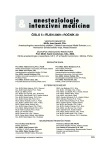Induction and recovery times for general anaesthesia – a prospective study
Authors:
Černý Vladimír 1; Cvachovec Karel 2; Ševčík Pavel 3; Vítková Kateřina 1; Minarčíková Petra 3; Gavulová Eva 2; Dostálová Vlasta 1; Schreiberová Jitka 1; Novotný Tomáš 1; Machalová Gabriela 1; Brujevič Jan 1; Silová Xenie 1; Stoszková Andrea 1; Parnicová Emília 1
Authors‘ workplace:
Klinika anesteziologie, resuscitace a intenzivní medicíny, Univerzita Karlova v Praze, Lékařská fakulta v Hradci Králové, Fakultní nemocnice Hradec Králové
1; Klinika anesteziologie a resuscitace, Univerzita Karlova v Praze, 2. lékařská fakulta a IPVZ
Fakultní nemocnice Motol, Praha
2; Klinika anesteziologie, resuscitace a intenzivní medicíny, Lékařská fakulta Masarykovy univerzity Brno, Fakultní nemocnice Brno
3
Published in:
Anest. intenziv. Med., 20, 2009, č. 5, s. 236-240
Category:
Anaesthesiology - Original Paper
Overview
Objective:
To establish general anaesthesia induction and recovery times.
Design:
A prospective observational study.
Setting:
Three large university hospitals.
Materials and methods:
This study enrolled patients undergoing elective surgical procedures under general anaesthesia not expected to require postoperative ICU/HDU admission from 1st May till 30th June 2008. Patients who remained intubated after the surgical procedure were excluded from the final analysis. The observed parameters included gender, age, ASA, surgical procedure, airway management, anaesthetic drugs used, and anaesthesia induction and recovery times.
Results:
The analysis included data from 1300 patients; mean patient age was 44 years. Opioids and isoflurane were the most frequently used drugs (opioids in 1095 [84%] patients and isoflurane in 971 [75%] patients). Neuro-muscular blocking drugs (NMBD) were used in 770 (59%) patients. Tracheal intubation was used in 65% procedures and laryngeal mask airway in 29% procedures. The mean induction time was 9 minutes (CI 95% 8.7–9.7, range 1–100), the mean procedure duration 91 minutes (CI 95% 87–94, range 3–690); the mean recovery time was 3 minutes (CI 95% 2.9–3.2, range 0–35). Patients given NMBD showed a statistically significant increase in recovery time (3.5 min, CI 95% 3.3–3.7 vs. 2.4 min, CI 95% 2.2–2.6; p < 0.001). Procedure duration correlated with recovery time (correlation coefficient = 0.114; p < 0.001).
Conclusion:
The general anaesthesia mean induction time was 9 minutes and mean recovery time 3 minutes. These findings correspond with published data from other countries. The leading factors contributing to increased recovery times were the use of midazolam, NMBD and tracheal intubation, and procedure duration.
Keywords:
general anaesthesia – induction – recovery
Sources
1. Punjasawadwong, Y. et al. A Bispectral index for improving anaesthetic delivery and postoperative recovery. Cochrane Database Syst. Rev., 2007, 17, 4, CD003843.
2. Bhagat, H. et al. Planning for early emergence in neurosurgical patients: a randomized prospective trial of low dose anesthetics. Anesth. Analg., 2008, 107, p. 1348–1355.
3. Katznelson, R. et al. Accelerated recovery from sevoflurane anesthesia with isocapnic hyperpnoea. Anesth. Analg., 2008, 106, 486–491.
4. Gozdemir, M. et al. Remifentanil-propofol in vertebral disk operations: hemodynamics and recovery versus desflurane-n(2)o inhalation anesthesia. Adv. Ther., 2007, 24, p. 622–631.
5. Rohm, K. D. et al. Do patients profit from physostigmine in recovery from desflurane anaesthesia? Acta Anaesthesiol. Scand., 2007, 51, p. 278–283.
6. Juvin, P. et al. Emergence of elderly patients from prolonged desflurane, isoflurane, or propofol anesthesia. Anesth. Analg., 1997, 85, p. 647–651.
7. Goto, T. et al. Xenon provides faster emergence from anesthesia than does nitrous oxide-sevoflurane or nitrous oxide-isoflurane. Anesthesiology, 1997, 86, p. 1273–1278.
8. Guy, J. et al. Comparison of remifentanil and fentanyl in patients undergoing craniotomy for supratentorial space-occupying lesions. Anesthesiology, 1997, 86, p. 514–524.
Labels
Anaesthesiology, Resuscitation and Inten Intensive Care MedicineArticle was published in
Anaesthesiology and Intensive Care Medicine

2009 Issue 5
Most read in this issue
- Induction and recovery times for general anaesthesia – a prospective study
- Cancellations of scheduled surgical procedures in three Czech university hospitals – a prospective study
- Regional citrate anticoagulation during continuous renal replacement therapy (CRRT) in a cardiac surgery patient with a high risk of bleeding – case report
- Age of packed red blood cells and its influence on concentration of selected biochemical values
